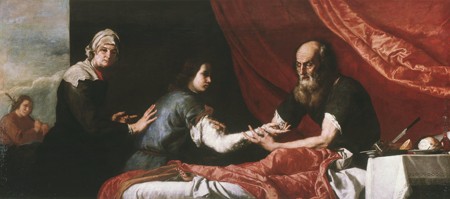These works of art exemplify Ribera’s participation in the broad discussions of his generation about the role of pictures in negotiating the connections between the sensible world of bodies and things and the knowledge of the invisible and/or intangible. I have found that Ribera probed art’s ability to mediate between seeing and knowing by emphasizing and anticipating the ways in which his viewers could probe his paintings. In previous studies, connoisseurship, understood in its contemporary sense as a preoccupation with attribution and stylistic chronology, has been the dominant approach to Ribera’s art; by contrast, I have traced its hitherto unexplored relevance to the artist and his contemporaries as a set of interpretive practices. Ribera cared about how people looked at paintings, and his works both anticipate and creatively redirect the discussions that could take place in front of them.
This emphasis on the phenomenon of looking is evident in the dynamic overlap between Ribera’s early activity as a producer of easel paintings and new practices of exhibiting and discussing works of art that were developing in Rome in the first two decades of the seventeenth century. Ribera participated in this culture of connoisseurship by cultivating an
The conversational practice of considering paintings was relevant to Ribera not only because it was the way his patrons “used” their art collections; spoken art criticism was also intellectually potent, an active ingredient in Ribera’s approach to his pictures. In Isaac and Jacob, for instance, the crux of the scene is not the blessing or even the deception of Isaac but his consideration of the evidence that is offered to him as he touches the goat’s hair covering Jacob’s arm. Alberto Frigo’s suggestive remark that blind Isaac would make the best patron saint for connoisseurship finds ample support in the careful scrutinies invited and carried out by Ribera’s blind patriarch. Far from asserting a triumphalist equivalency of image-making with the production of knowledge, Ribera’s painting explores the capacity of sensory experience, first and foremost that of looking at paintings, both to lie and to tell the truth, or to tell a truth that is concealed rather than exposed by the information conveyed by the senses.
The case studies in my project demonstrate Ribera’s awareness of art’s potential to package and present different sorts of knowledge for examination. His insistence in these images on the act of evaluation rather than on surrender to sensory experience runs counter to the received wisdom that positions the Catholic culture of southern Italy and Spain (and, by extension, most of Ribera’s oeuvre) as propagandistic and anti-intellectual. What I found instead was the immense relevance and originality of Ribera’s participation in his generation’s vigorous questioning of what pictures are, what it means to look at them, and what they have authority to do and communicate.
